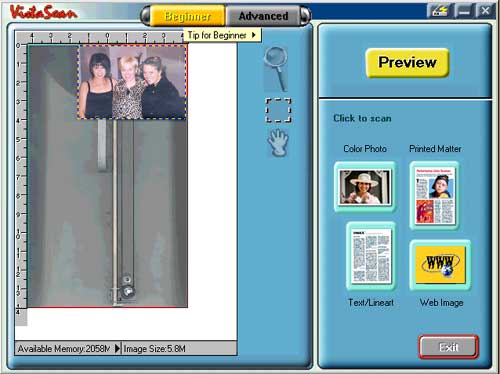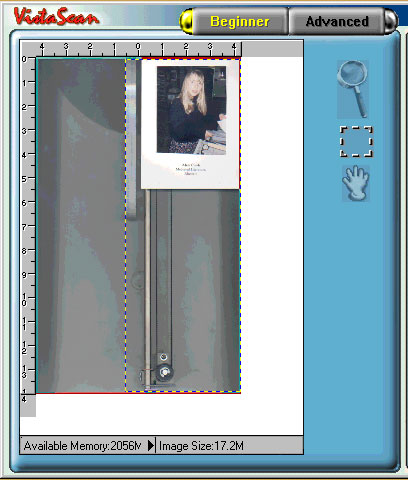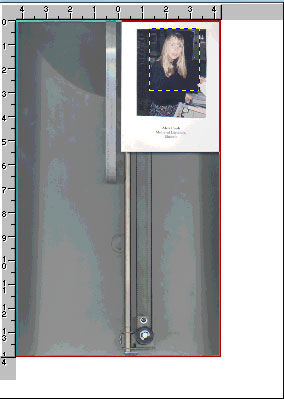Scanning Basics
How-To's for Adding a Custom Image
to your Web Page
Step 1: Setting Up
1. Look around the Transcriptions Studio and locate
the computer that is attached to the scanner (a rectangular
machine labeled "UMAX: Astra 4000U."
a. Turn on the scanner (flip the switch located at the
back of the machine from "O" to "I".
After its initial startup, the scanner light (at the front
of the machine) should be green. If the light is flashing,
turn the scanner off for a moment and then turn it on again.
When the light is solid green, proceed to step b.
b. If the computer to which the scanner is attached is
already running, you must restart the computer so that it
will recognize its attachment to the scanner. (To restart,
go to the "Start" menu on the bottom left of the
computer, choose "Shut Down." When the options
window pops up, choose "Restart."
2. When your computer has finished restarting, open Photoshop.
To do this, double click on the Photoshop icon on your desktop,
or go to the "Start" menu and select Programs>Adobe>Photoshop
5.5.
3. To open the Scanner software within Photoshop, choose
File>Import>Twain_32. The "Vista Scan"
software will pop up on your screen.
Step 2: Scanning the Object: transforming your visual image
(photograph, drawing, etc.) into digital data
1. At the top of the Vista Scan screen, there are two options:
"Beginner" and "Advanced." If this is
your first time scanning an image, choose Beginner.
Note: The difference between the "Beginner"
and the "Advanced" options is that in the former
you defer to the default setup for the various settings
needed for scanning, such as digital colour complexity,
resolution (dpi), filters (blurring and sharpening the image),
and size of the image (percentage of the image you want
to reproduce in relation to actual size), whereas with the
latter you choose these settings yourself. If you become
interested in manipulating these settings in order to create
specific aesthetic effects later on, you can choose Advanced
and play around with it.
2. Next, become familiar with the "Beginner"'s
Vista Scan screen:

a. On the top right hand side of the screen is the "Preview"
button.
b. Below this button is a series of choices (Color Photo;
Printed Matter; Text/Lineart, Web Image); the selection
of one of these buttons (whichever best matches the image
you wish to scan) will give the actual Scan command and
manipulate the default settings to accord with the given
description you have chosen.
c. Finally, the left side of the screen is your workspace;
this space will be where you view your preview scans.
Note: You may see preview scan images that do
not belong to you on the left side of the screen. Don't
worry, this is simply a result of the fact that this software
remembers the last preview scan the computer/scanner performed.
When you perform your preview scan in a few moments, this
image will be replaced by your image.
3. Open the scanner and place the image you wish to scan
facing downward at the top left corner of the glass frame,
flush with the scanner's ruled edges. This will ensure that
you scan your image in straight (rather than crooked).
Note: You don't need to worry too much whether your
image is spatially oriented in the way you wish it to be
viewed on your web page (right side up, in other words).
You will be able to manipulate your image to be oriented
correctly in Photoshop after the image has been scanned
in.
4. Now you are ready to perform a preview scan, which can
be thought of as a dress rehearsal of the actual scan. Click
on Preview. A small window will pop up showing you
the progress of your preview scan and giving you the option
to "abort," which you do not want to do. You will
hear the scanner whirring as it performs this preview.
Note: Preview scans are by definition "low
resolution," (meaning not digitally complex, not requiring
a lot of information memory/storage), so this action should
take less than a minute to perform regardless of the size
of your image.
5. You will see a small representation of the image you preview
scanned on the left side of your Vista Scan screen. A long
rectangular blinking box will encompass your image.

The entirety of the contents of the rectangular box represents
what you will actually scan in when you perform the actual
scan in a few moments. Your goal is to make this space as
small as you can while still allowing room for your image
to be scanned in its entirety. To do this:
a. Move your cursor to the bottom of the blinking rectangle
(the farthest lower point from your image).
b. You will see your cursor turn into a bi-directional
arrow. This arrow will allow you to drag the rectangle to
a disired position.
c. Move the rectangle until it is flush with your image
on all sides. Manipulate the blinking rectangle with the
arrow cursor until the rectangle is flush around your image
on all sides.
Note: If you wish to scan only a portion of your
image, you can move the blinking rectangle to whatever
portion of the image you wish to scan. For instance, in
the illustration below, I have chosen to scan only a framed
portion of the photograph I have Previewed (that which
is inside the blinking rectangle):

6. Now you are ready to scan the image for real. Choose one
of the four scanning options. Choose according to which of
these options (Color Photo; Printed Matter; Text/Lineart,
Web Image) best describes the image you wish to scan.
Note: Here is a list of the default settings which
define each of the four options:
Color Photo is meant for color photographs, obviously,
and will scan with "True Color" at 300 dpi (dots
per inch, which refers to the density of digital data
defining your image, otherwise known as resolution).
Text/Lineart is meant for unprinted matter (for
instance, drawings or hand-written text documents) and
will scan with "Black and White" at 300 dpi.
Printed Matter is meant for printed documents
of all kinds and will scan with "True Color"
at 150 dpi.
Web Image will automatically adjust your image
to be web-safe by scanning at "216 Colors" at
the most popular resolution for web images, which is 72
dpi.
Note: There are reasons both for and against
choosing "Web Image" at this juncture in your
scanning career. If you simply want to play it safe
and know that your image will be the scanned
in an appropriate file size for the web, then choose
this option now. On the other hand, choosing from among
the other three options according to which best describes
your image will scan your image in at a higher resolution,
giving you more editing leeway as you manipulate your
digital image. You will be able to save it in an appropriate
file size for the web later in this case.
Note: A rule of thumb when dealing with digital
images is that you can always degrade the resolution
of the image, but you cannot upgrade the resolution.
7. Click on the scanning option you have chosen. This will
give the command for the computer and scanner to perform the
actual scan of your image. A small window will pop up and
keep you updated on the progress of the scan until the process
is complete.
8. You will see the representation of your image pop up behind
the Vista Scan window when the scan is complete. In order
to begin editing this image, you must close the Vista Scan
software.
Step 3: Editing Your Image and Formatting It for the Web
1. The first thing you will want to do is save your image
to a drive (probably the D:\ drive: your zip disk), so that
if you do not complete your work in this sitting or if the
computer crashes you will not have lost your work up to this
point. It is smart to set up a folder on your zip disk called
something like "Photoshop Images." Use this folder
to store images in the .psd format, which is the format
native to Photoshop.
Note: Eventually you will have to "Save As" the
document in either a .jpg or a .gif (which
are the web-compatible formats), but it is a good habit
to keep your original .psd file too.
Note: The .psd format is extremely valuable to you if you
wish to make alterations to your image. For one thing, this
format saves your image as a large file with a great deal
of digital complexity (whereas a .jpg or .gif compresses
your image into a much smaller file with much less digital
complexity). For another thing, you can save your image
file (as you continue to alter the image) continuously without
degrading it (whereas each time you save a .jpg or .gif
file, it re-compresses and degrades). Until you are ready
to place your image in a web page, then, it is a good idea
to work with it as a .psd file.
In order to save your document as a .psd file, go to File>Save.
Navigate to your "Photoshop Images" folder on your
disk, give your document a name, and make sure you select
".psd" as the file type. Then press "Save."
2. If necessary, rotate your image so that it is right-side
up on your Photoshop screen. To do this, go to Image>Rotate
Canvas, and rotate your image in whatever direction and
degree is appropriate.
3. The next thing you will want to do now is to resize your
image so that it is an appropriate size for the Web. Since
most monitors display 800X600 pixels, your image cannot exceed
these dimensions. Go to Image>Size on the Photoshop
menu at the top of the screen. A window will pop up containing
the data of your image's size. Choose the "pixels"
option for both width and height and then make sure your image's
width is no more than 600 pixels. (If it is larger than 600,
erase the width shown, type in 600, and press "OK."
Feel free to make your image smaller if you wish.
Note: Notice the representation of a chain between
the width and height of your image. This chain represents
the fact that the width and height of your image is "locked
together" in Photoshop, meaning that when you change
the width of your image, Photoshop will change its height
automatically such that the proportions of the image's original
size remain intact.
4. Next, detect the percentage of your image's true size
Photoshop is currently representing to you. Look around your
Photoshop screen for a small box titled "Navigator,"
within which is a small version of your image. If you do not
see this box, go to Window>Show Navigator and it
will appear on your screen.
Note: Sometimes you must look carefully to find
the Navigator box (and other similar items) on your Photoshop
screen. If you go to Window and can only find a "Hide
Navigator" option on the pull-down menu, then the Navigator
box is most likely lurking beneath something else on the
Photoshop screen. You can drag these small boxes around
to different places on your screen to see if anything is
hiding beneath them.
The default setting in the Navigator box for the percentage
of your image displayed on the Photoshop screen is 66.6%.
It is a good idea to slide the arrow to the right on the Navigator
box until the image reaches 100%. This way you will know exactly
how large your image actually is.
Note: After you discover the actual size of your
image, you may wish to adjust the Navigator box again to
suit the particular needs of the image you are working with.
For instance, iIf you are working with an especially small
or especially large image, this percentage-shown function
can come in real handy. You can enlarge the given image
beyond 100% in order to see the details of the image better;
conversely, you can shrink the image if it is too large
to fit on the Photoshop screen in its entirety in its actual
size. Once again though, if the image is a manageable size
at 100%, then it is perhaps most convenient to keep the
adjustment there to remind you of what you are actually
working with size-wise.
5. Photoshop offers many tools for altering the properties
of your image. To browse your options or to look up directions
for how to use a tool in Photoshop, go to Help>Help
Topics.
6. When you are pleased with the outcome of your image and
are ready to place it into a web page, it is time to save
the image in a web-compatible format. Go to File>Save
As. Navigate on your zip disk to the "Images"
or "Graphics" folder you have created for the page
or site into which you wish to place this image. Give your
image a name (this can be the same name as it carries as a
.psd file) and make sure that you select either the .jpg (best
for photographs) or .gif (best for most other things) format.
Then press "Save."
Now you are ready to place your image in a
web page. If you need help with this, please see our Getting
Started with Dreamweaver
page.
Good luck!
|